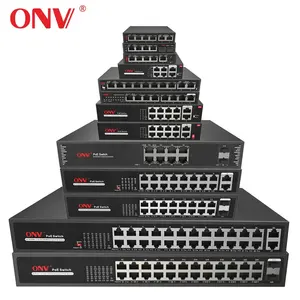(17682 products available)












































































































































































































4-port network switches come in a variety of configurations to serve the different consumer and enterprise needs. These include Ethernet switches, PoE switches, managed switches, and unmanaged switches.
These are the most common types of 4-port network switches used in relatively straight networking situations. They offer numerous Ethernet ports to connect different devices within a local network, enhancing network traffic control and improving communication between devices.
These switches carry electrical power and network data through an Ethernet cable to devices such as IP cameras, access points, and VoIP phones. This feature eliminates the need for separate power sources, simplifying installation, especially in locations where accessing power outlets is difficult.
These switches provide advanced settings, paying per leasehold interest, and network monitoring. They support the creation of virtual local area networks (VLANs), traffic prioritization, and other features that allow for more efficient and secure network administration. Organizations with complex networking needs usually prefer managed switches due to the greater control they provide over network operations.
These switches offer basic plug-and-play connectivity without advanced features. Although they lack the configurability of managed switches, unmanaged ones present a cheap and straightforward answer for small enterprises or homes that desire extra network capacity without complicated management interfaces.
To adequately select and maintain these switches, understanding their major specifications is necessary. The following are those specifications:
To keep these switches in working condition, appropriate maintenance is required. The following are some of the ways to do that:
A 4-port network switch is used in different commercial applications. Based on their distinct roles, the situations for which they are intended can increase network capacity, simplify administration, and protect longer lifespans. Below are the instances where these switches are used:
These are primarily used to connect computers, printers, and IP phones. They offer a simple and affordable approach to creating a local network where employees can securely communicate and share resources. With three or four ports available, these switches usually satisfy the SB network requirements, especially when growth or rapid expansion is not anticipated.
Retail businesses use 4-port switches to connect point-of-sale systems, security cameras, and inventory management devices. This helps network system reliability because it supports smooth communication between essential systems, avoiding lags or outages that would hamper operations.
In office spaces, 4-port switches help connect various workstations to streamline communication and data-sharing processes. They serve as a central hub that expands the existing network infrastructure. With a focus on efficiency, these switches are usually integrated into larger networking systems.
Various remote sites, such as branches or field offices, use 4-port switches to set up local networks where network connectivity may go down. They connect all devices on the local area network, keeping everyone in communication even in the most isolated areas. This is crucial for companies with distributed workforces that require dependable network connectivity away from headquarters.
These 4-port switches provide an easy way to improve workgroups' networking capability. Whether the team is focused on sales, marketing, or any other departments, a dedicated switch ensures that their network is a reliable one. This enhances collaboration and productivity by reducing network congestion and providing stable connectivity for shared tools and applications.
4-port network switches, which boost network capacity and provide stable internet connectivity across different devices, are widely used at home. Below are the common domestic usage scenarios:
Smart home networks rely on 4-port switches to connect the many devices that make a home smart, such as security cameras, smart thermostats, lights, and home assistants. These switches provide the required network stability to keep all these devices interconnected, enabling them to communicate effectively for seamless operation.
For online gaming enthusiasts, a wired connection gives better speed and stability over Wi-Fi, especially in a busy household with several internet-using devices. A 4-port switch ensures that gamers get the advantages of a direct connection, reducing latency and improving game performance by providing a dedicated network line to their consoles or gaming PCs.
With remote work becoming more common, many people need reliable internet to represent work conferences, collaborate on projects, and access cloud services. A 4-port network switch provides stable connectivity for multiple home office devices, such as computers, printers, and IP phones, ensuring smooth operation during work hours.
Many families with multiple streaming devices, such as smart TVs, streaming sticks, or set-top boxes, need constant bandwidth for seamless content delivery. A 4-port switch enables users to connect all these devices to the internet wirelessly, avoiding buffering and ensuring high-quality streaming on multiple devices simultaneously.
In households where several people use the internet concurrently, a 4-port switch helps distribute network traffic evenly across devices. This prevents slowdowns during peak usage times, such as when one family member is working from home while others are gaming or streaming movies.
Yes, some network switches come with PoE. It enables the switch to supply power and data through the same Ethernet cable to any device needing external power, such as IP cameras, phones, or access points.
A managed switch is more flexible because it has features for configuring, monitoring, and controlling the network traffic flow. On the contrary, unmanaged switches are just plug-and-play and require no configurations.
Yes. It will be easy to daisy-chain several 4-port switches together to increase the number of available ports on a network without significantly increasing network size or congestion.
Connecting a gaming PC to a switch will provide a more steady and reliable network connection than Wi-Fi, especially in homes where several devices are connected simultaneously. This lessens lag and gives a better gaming experience.
The decision should depend on one's networking needs. If the network is simple and straightforward, an unmanaged switch is ideal. On the other hand, a managed switch is better for complex networks needing close monitoring and administration.